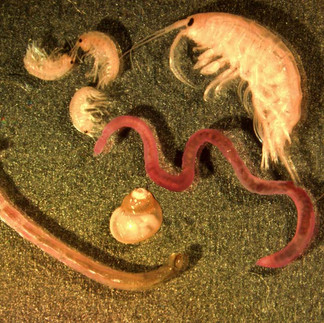Benthic Organisms: The Key to Forensic Science?
- louisahoy
- Feb 20, 2023
- 4 min read
Forensic scientists often study the behaviour of terrestrial organisms and their interactions with dead bodies in investigations to give insight into important knowledge, such as how long a particular body has been in one place. However, few scientists have looked at aquatic organisms that colonise submerged corpses. Many scientists study terrestrial environments and attempt to apply the principles to the aquatic environment, however, there are no truly aquatic insects whose diets consist solely of decomposing matter (1), whereas there are in terrestrial ecosystems. This makes a comparison between the two environments unreliable, and it indicates that further study into decomposition by aquatic organisms should be carried out.
How can benthic organisms be used in forensics?
Studying the diversity and composition of biota present on a body enables the Post-mortem Submersion Interval (PMSI) to be accurately estimated, which is how long the body has been submerged (2). Studies on diatoms from recovered bodies have also been successful in ascertaining whether or not a death was the result of drowning and in determining the location of death (3); knowledge of which is extremely important in criminal investigations.
The decomposition of remains, once they are submerged, is dependent on a variety of factors, including sea floor sediment type, whether the body is floating or not, and the water chemistry (4). The time and date of death also play a significant role in determining the decomposition rate, since it differs both seasonally and daily (5). The organisms studied in these investigations are not always aquatic, they could be terrestrial too. This could come about by the body floating on the surface and being partially exposed to air or being partially washed onshore (2). Additionally, whether the body floats or sinks affects the decomposition rate, since a floating corpse can only be accessed by swimming or floating organisms (4), whereas a sunken one can also be colonised by benthic organisms.

The factors contributing to, retracting from, and modifying the benthic community on a submerged body (original figure).
Midge larvae are considered the most important benthic invertebrates because they are found in great numbers and are rapidly colonising, meaning they could colonise a submerged body in a very short period (2). Additionally, some types of midge larvae are cosmopolitan, which means that they can survive in a wide variety of habitats, therefore potentially helping in PMSI calculations over larger geographical areas (2).
How do bodies decompose?
The decomposition of a body can be split into 5 stages (visualised in the figure below), defined principally by Haefner in 2004 (1):
Submerged fresh
Early floating
Early floating decay
Advanced floating decay
Sunken remains
Some scientists include a sixth stage of “bloated deterioration”, however Haefner and his team found no discernible difference between this stage and “floating decay”, therefore decided to remove it. At each stage, the action of benthic organisms will vary, particularly since some stages are on the sea floor and some are at the surface, hence enabling scientists to determine the stage of decomposition of a body rapidly upon retrieval from the water.

The five stages of decomposition on a submerged body (original figure).
The benefit of colonising a corpse, from the point of view of a benthic organism, is the provision of nutrients since the decomposition of the body releases nutrients into the surrounding water (1) and aids photosynthesising species, such as algae, in primary production.
Case Study
In 2009, scientists Merritt and Wallace (6) described a particularly interesting case from 1989 where data regarding benthic organisms, specifically aquatic insects, influenced a prosecution in court. A car containing a murder victim was pulled from a river, having previously sunk, only to discover it had been completely colonised by aquatic black flies. Analysing the species composition and life stages of these flies allowed for an accurate PMSI to be estimated. As a result, the prosecutors were able to contradict the account of the murder suspect regarding the victim’s last known whereabouts. The suspect was then convicted of the murder. In this case, the black fly colonisation contributed significantly to the outcome of the case, highlighting the future potential for utilising benthic communities in forensic investigations.
So, what do we do now?
Research into the behaviour of benthic organisms upon the discovery of a dead body is constantly expanding and growing. As it stands, relatively little is known on this topic, but the potential use for it is extraordinary. Last year, there were 594 recorded homicide victims in England and Wales (7), with many more unknown to this day. This research can pave the way for prosecuting murderers with undeniable scientific evidence, as well as simply gaining knowledge about unexplained deaths and drowning events.
Literature Cited
Haefner J, Wallace J, Merritt R. Pig decomposition in lotic aquatic systems: the potential use of algal growth in establishing a Postmortem Submersion Interval (PMSI). Journal of Forensic Sciences. 2004;49(2):330-6.
Keiper J, Casamatta D. Benthic organisms as forensic indicators. Bridges. 2001;20(2):311-24.
Colombage SM, Telisinghe PU. An unusual finding in a body recovered from the sea. Journal of Forensic and Legal Medicine. 2010;17(5):289-90.
Anderson GS, Hobischak NR. Decomposition of carrion in the marine environment in British Columbia, Canada. International Journal of Legal Medicine. 2004;118(4).
Dickson GC, Poulter RTM, Maas EW, Probert PK, Kieser JA. Marine bacterial succession as a potential indicator of postmortem submersion interval. Forensic Science International. 2011;209(1-3):1-10.
Merritt R, Wallace J. The role of aquatic insects in forensic investigations: CRC Press; 2009. 271-319.
Office for National Statistics. Homicide in England and Wales: year ending March 2021 2021 [https://www.ons.gov.uk/peoplepopulationandcommunity/crimeandjustice/articles/homicideinenglandandwales/yearendingmarch2021].





















Comments